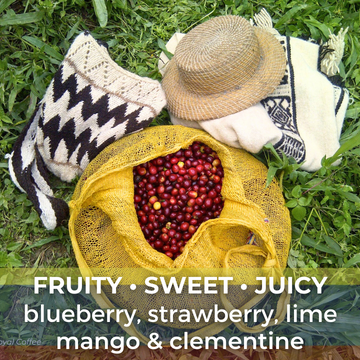Peru Cajamarca Alto San Ignacio Huellas
For the first time ever, Catalyst is adding Peruvian coffees to their lineup of premium quality offerings. It's taken years of making connections and building relationships with some of the best producers in the country, but their hard work has finally paid off. Out of their handful of curated offerings, we chose this community lot from the Huella Program. Huella, which means “footsteps”, is focused on a community of neighbors and families working together to create a whole that’s better than the sum of its parts. While we often heap praise on individual farmers who distinguish themselves, it’s easy to forget that a community of farmers working in harmony can produce something even greater. Taste this cup and you’ll know what we mean.
We’ve always enjoyed having Peruvian coffees because they fill a niche in our line-up. Usually that niche is for folks who are looking for a delicate, subdued, easy drinking cup. This coffee broke that mold. This is easily the richest and most flavorful Peruvian coffee I’ve ever had, full stop.
The cup is delightfully balanced and clean with body for days. We tasted rich notes of milk chocolate, juicy orange, spiced rum, and peach syrup, giving it a surprising sweetness for a washed coffee. In our lighter roasts, we also noted sweet ruby grapefruit and lovely florality in the cup, possibly lavender or what Catalyst describes as marigold. If you’ve had the same lackluster experience in the past with Peruvian coffee that we’ve had, you’ve got to try this coffee. You’ll never think about Peruvian coffee the same way again.
Arrival Date: January 17, 2023; Harvest year: 2022, packed in GrainPro
Acidity & Brightness: Bright and fairly sweet
Balance & Finish: Balanced with a clean finish
Body & Texture: Rich body and creamy texture
Flavors: Milk chocolate, orange, spiced rum, peach syrup
Grade: SHG, Grown at 1550-1850 masl
Processing: Fully washed, fermented for 17-24 hours (depending on the temperature), followed by washing three times, and spread to dry under solar tents
Grower: A community lot of 9 local producers’ coffees | Neuvo Progreso and Señor Cauivo farmhouses | Program Huellas
Region: San Ignacio, Cajamarca, Peru
Varieties: Caturra, Bourbon
Recommended Roast Range: City + to Full City + (Light-medium to medium-dark)
Start at City + (light-medium) or just about 1 minute into rolling first crack. From there, go a bit darker if desired, but find it best not to go any darker than Full City + (Medium-dark or right at the first few snaps of second crack). Most folks will prefer a Full City or after first crack has ended and before second crack begins. Lighter roasts will have more tangy acidity turning the ripe orange note into ruby grapefruit. You will also get more florality at the expense of chocolate and body. Medium-dark roasts will accentuate more body and spice as well as caramelly sweetness at the expense of subtle notes like peach.
Catalyst Trade - “A community lot in the true sense of the word, 9 producers’ coffees make up this lot. All hail from the San Ignacio area, with some being just over the ridge or downslope from the each other, they are neighbors and in some cases family members, working together for community and sustainability, each on their own piece of Peru.
All are members of Programa Huella (Footsteps). Catalyst Trade has some of these producers’ single farm nano lots as well, and we fell in love with the blended terroir of Cajamarca showcased here. These farmers work hard to grow, harvest and process their coffees before bringing them to key collection points—Nuevo Progreso and Señor Cauivo farmhouses, whichever one is closest to their farms.
Their coffee trees are produced in an agroforestry system, (a large, evergreen variety of pine tree), cedar, pacae (guava) and banana which grow throughout the mountainous terrain. As is the norm here in Peru, each farm has its own micromill, with either a hand pulper or one attached to a small gasoline motor. Pulped beans are routed into a tank for fermentation (17-24 hours, usually, depending on the temperature), and afterwards are washed three times before being spread to dry under solar tents to keep the frequent mists and rains off the drying parchment.
Once moisture reaches the optimal level, the producers bag up their parchment coffee and bring it to the closest collection point. From there, the bags are trucked to a processing plant to be readied for export.”


















